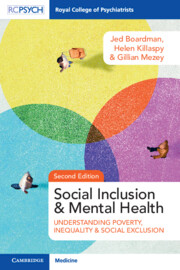Book contents
- Social Inclusion and Mental Health
- Reviews
- Social Inclusion and Mental Health
- Copyright page
- Contents
- Foreword to Second Edition
- Foreword to First Edition (2010)
- Preface
- Acknowledgements
- Chapter 1 Introduction: Poor, Excluded, and Unequal
- Section 1 Social Exclusion, Poverty, and Inequality
- Section 2 Participation of People with Mental Health Conditions
- Chapter 9 Mental Health Inequalities and Exclusion
- Chapter 10 Exclusion from Material Resources
- Chapter 11 Exclusion from Socially Valued Activities
- Chapter 12 Exclusion from Social Relations and Neighbourhoods
- Chapter 13 Exclusion from Health and Health Services
- Chapter 14 Exclusion from Civic Participation
- Chapter 15 Social Exclusion in Specific Social Groups and Individuals with Mental Health Conditions
- Chapter 16 Social Exclusion and People with Mental Health Conditions: Developing a Clearer Picture
- Section 3 Including People
- Index
- References
Chapter 12 - Exclusion from Social Relations and Neighbourhoods
from Section 2 - Participation of People with Mental Health Conditions
Published online by Cambridge University Press: 24 November 2022
- Social Inclusion and Mental Health
- Reviews
- Social Inclusion and Mental Health
- Copyright page
- Contents
- Foreword to Second Edition
- Foreword to First Edition (2010)
- Preface
- Acknowledgements
- Chapter 1 Introduction: Poor, Excluded, and Unequal
- Section 1 Social Exclusion, Poverty, and Inequality
- Section 2 Participation of People with Mental Health Conditions
- Chapter 9 Mental Health Inequalities and Exclusion
- Chapter 10 Exclusion from Material Resources
- Chapter 11 Exclusion from Socially Valued Activities
- Chapter 12 Exclusion from Social Relations and Neighbourhoods
- Chapter 13 Exclusion from Health and Health Services
- Chapter 14 Exclusion from Civic Participation
- Chapter 15 Social Exclusion in Specific Social Groups and Individuals with Mental Health Conditions
- Chapter 16 Social Exclusion and People with Mental Health Conditions: Developing a Clearer Picture
- Section 3 Including People
- Index
- References
Summary
This chapter examines the importance of family, social networks, social capital, and personal safety to people with mental health conditions and how these are often missing from their lives and replaced by social isolation and loneliness. For people with mental health conditions, social contacts and levels of support play a role in the genesis of their conditions as well as their recovery. People with mental ill-health often lack access to some forms of social capital but may benefit from the buffering effects of other forms. Social interaction may be curtailed by the subjective experiences of the mental health conditions, but also from the stigma and discrimination experienced by people with mental health conditions as personal experience of or fear of crime, aggression, and persecution. These are experiences that can set up a vicious cycle of loneliness and depression and exclusion for social contacts and important sources of support. These mental health and social conditions are unevenly distributed and exacerbated by the nature of the physical and social conditions of neighbourhoods. Whilst communities can be supportive, they may also present unacceptable risks to vulnerable groups in the form of crimes and victimisation.
Keywords
- Type
- Chapter
- Information
- Social Inclusion and Mental HealthUnderstanding Poverty, Inequality and Social Exclusion, pp. 249 - 273Publisher: Cambridge University PressPrint publication year: 2022

